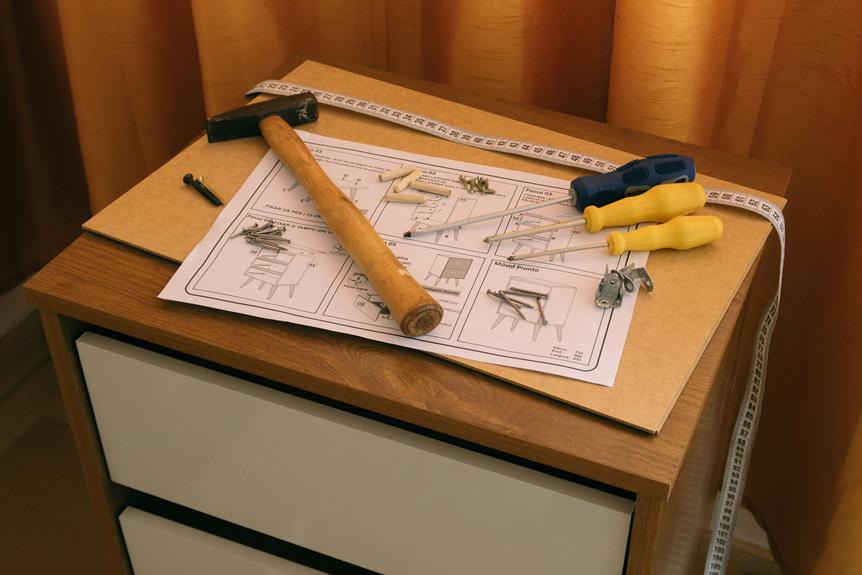So, you’ve just finished building a beautiful wooden dining table from scratch. Now comes the crucial step of applying a finish to protect and enhance the wood surface.
But how do you properly apply a finish to wood surfaces? In this guide, we will walk you through the process, step by step, so you can achieve a flawless and long-lasting finish.
From understanding different types of wood finishes to choosing the right one for your project, we’ll cover it all. Get ready to bring out the natural beauty of the wood and make your project truly shine.
Let’s dive in and learn how to properly apply a finish to wood surfaces!
Key Takeaways
- Understanding different types of wood finishes: natural, synthetic, eco-friendly, water-based.
- Preparing the wood surface for finishing: proper sanding, choosing the right sealant.
- Choosing the right sealant: polyurethane, shellac, water-based, consider desired finish and protection level.
- Applying and maintaining the finish: applying the first coat, sanding and applying additional coats, applying a topcoat, regular cleaning, avoiding direct sunlight, using coasters and placemats, handling with care.
Understanding Different Types of Wood Finishes
To properly apply a finish to wood surfaces, you need to understand the different types of wood finishes available.
One important consideration when choosing a finish is whether to go for a natural or synthetic option. Natural wood finishes, such as linseed oil or beeswax, have been used for centuries and offer several benefits. They enhance the natural beauty of the wood by highlighting the grain and color, and they provide a warm and inviting look. Additionally, natural finishes are often non-toxic and can be easily repaired if damaged.
On the other hand, synthetic finishes, like polyurethane or lacquer, offer increased durability and protection against moisture, scratches, and UV damage. They can provide a smoother and more glossy finish, and are generally easier to apply.
In recent years, there’s been a growing interest in eco-friendly wood finishes. These options prioritize sustainability and minimize the impact on the environment. Some eco-friendly finishes are made from renewable resources, while others are water-based and have low VOC (volatile organic compounds) content, reducing the emission of harmful chemicals. Additionally, some finishes are made from natural ingredients, such as plant oils or resins.
Exploring eco-friendly wood finish options allows you to protect both your health and the environment while still achieving a beautiful and long-lasting finish for your wood surfaces.
Preparing the Wood Surface for Finishing
Before applying a finish to your wood surfaces, it’s important to properly prepare the wood. This involves using the right sanding techniques to ensure a smooth and even surface.
Additionally, choosing the right sealant is crucial for protecting the wood and achieving the desired finish.
Sanding Techniques for Finishing
Start by sanding the wood surface using a fine-grit sandpaper. Sanding is an important step in preparing the wood surface for finishing.
You have two options: wet sanding or dry sanding. Wet sanding involves using water or a lubricant to reduce friction and prevent the sandpaper from clogging. This method is ideal for achieving a smooth and polished surface.
On the other hand, dry sanding is done without any liquid and is suitable for removing rough patches and imperfections. Whichever method you choose, make sure to sand in the direction of the wood grain to avoid damaging the surface.
Once you have finished sanding, you can move on to the next step of choosing the right sealant to protect and enhance the wood.
Choosing the Right Sealant
Now, let’s explore how you can choose the right sealant to prepare the wood surface for finishing.
There are various sealant options available, each with its own benefits and application techniques.
One popular choice is polyurethane, which provides durability and protection against moisture and heat. It can be applied with a brush or sprayed on for a smooth finish.
Another option is shellac, a natural sealant that dries quickly and offers good resistance to water and alcohol. It can be applied using a brush or a cloth pad.
For a more eco-friendly choice, consider using a water-based sealant. These sealants are low in VOCs and are easy to clean up. They can be applied with a brush or roller.
Choosing the Right Finish for Your Wood
To ensure a successful application, begin by carefully selecting the appropriate finish for your wood surface. There are various options available, each with its own unique characteristics and benefits. Consider factors such as the type of wood, desired appearance, and level of durability when making your decision.
One option to explore is eco-friendly alternatives. These finishes are made from natural and sustainable ingredients, reducing the impact on the environment. They are free from harmful chemicals and emissions, making them a healthier choice for both you and the planet.
Another option worth considering is natural oils. These finishes penetrate the wood, enhancing its natural beauty and providing protection from moisture and UV rays. Natural oils are easy to apply and maintain, making them a popular choice for those who prefer a more organic approach. They also offer the benefit of being easy to repair, allowing you to touch up any areas that may become worn or damaged over time.
To help you make an informed decision, here is a table outlining the different finishes and their key characteristics:
| Finish Type | Characteristics |
|---|---|
| Varnish | Provides a glossy finish |
| Lacquer | Offers a durable coating |
| Shellac | Provides a smooth finish |
| Wax | Enhances wood’s natural beauty |
| Polyurethane | Provides excellent protection |
Once you have chosen the right finish for your wood, it’s time to move on to applying the first coat.
Now that you have selected the perfect finish for your wood surface, let’s move on to applying the first coat of finish.
Applying the First Coat of Finish
Begin the application process by evenly spreading the first coat of finish onto the wood surface using a brush or cloth. Proper application of the first coat is crucial for a smooth and durable finish. Here are some key points to keep in mind:
- Even coverage: Ensure that the finish is evenly spread across the entire wood surface. This will prevent uneven drying and potential issues with the final appearance.
- Avoid over-application: Applying too much finish can lead to longer drying times and potential drips or runs. Use a steady hand and apply a thin, even layer for best results.
Now that you have applied the first coat of finish, it’s important to consider the drying time. Different finishes have varying drying times, so be sure to check the manufacturer’s instructions. Allow the finish to dry completely before moving on to the next steps.
Transitioning into the next section, after the first coat has dried, it’s time to proceed with sanding and applying additional coats. Sanding will help smooth out any imperfections and create a better surface for subsequent coats.
Sanding and Applying Additional Coats
After the first coat has dried, you’ll want to sand the wood surface and apply additional coats for a smoother and more durable finish. Sanding is an essential step in the finishing process as it helps to remove any imperfections and create a smooth surface for the subsequent coats. When sanding, it’s important to use the right techniques to achieve the best results.
Start by using a fine-grit sandpaper, such as 220 grit, and sand in the direction of the wood grain. This will help to avoid any scratches or marks on the surface. Be sure to sand evenly and apply consistent pressure to achieve a uniform finish. Once you have finished sanding, wipe away any dust or debris with a clean cloth before applying the next coat.
When applying additional coats, it’s crucial to follow proper application techniques. Use a clean brush or applicator and apply the finish in thin, even coats. This will help to prevent drips or bubbles from forming. Allow each coat to dry completely before applying the next one. Depending on the type of finish you’re using, you may need to apply multiple coats to achieve the desired level of protection and sheen.
Finishing Touches and Maintenance Tips
Once you have applied multiple coats and achieved the desired level of protection and sheen, it’s time to focus on the finishing touches and maintenance tips to ensure your wood surface stays beautiful for years to come. Here are some important finishing techniques and tips for protecting wood surfaces:
- Apply a topcoat: After the final coat has dried, apply a clear topcoat to provide an extra layer of protection. This will help guard against scratches, stains, and UV damage.
- Regular cleaning: To maintain the appearance of your wood surface, make sure to clean it regularly with a soft cloth or sponge. Avoid using harsh chemicals or abrasive cleaners that can damage the finish.
- Avoid direct sunlight: Exposure to direct sunlight can cause the wood to fade and lose its luster over time. Consider using blinds or curtains to protect your wood surface from excessive sunlight.
- Use coasters and placemats: To prevent water rings and heat damage, always use coasters and placemats when placing drinks or hot dishes on your wood surface.
- Handle with care: Be mindful of how you handle objects on your wood surface. Avoid dragging or dropping heavy items that can cause dents or scratches.
Frequently Asked Questions
How Do I Know if My Wood Surface Is Ready for Finishing?
To properly apply a finish to wood surfaces, you need to determine if it’s ready. Look for signs like smoothness, lack of visible defects, and dryness. These indicate that the wood is prepared for finishing.
Can I Apply a Different Type of Finish on Top of an Existing Finish?
Yes, you can apply a different type of finish over an existing finish. It can provide added protection, enhance the appearance, and offer different properties like durability or water resistance.
What Is the Best Way to Remove an Old Finish From Wood Surfaces?
To properly apply a finish to wood surfaces, the best techniques include sanding the surface, applying a primer, and then using a brush or roller to evenly distribute the finish. Alternative methods may include using a sprayer for a more even application.
How Long Should I Wait Between Applying Coats of Finish?
You should wait for the finish to dry completely before applying another coat. Applying finish on damp wood can lead to uneven results. Take your time and let each coat dry properly for the best outcome.
Can I Use the Same Type of Finish on Both Interior and Exterior Wood Surfaces?
You can use the same finish on both interior and exterior wood surfaces, but there are pros and cons. Factors to consider include durability, UV resistance, and temperature fluctuations.
Conclusion
Now that you know how to properly apply a finish to wood surfaces, you can transform your pieces into stunning works of art.
By understanding different types of wood finishes, preparing the surface, and choosing the right finish, you can achieve a beautiful and durable result.
Remember to take your time, follow the steps carefully, and don’t forget the finishing touches and maintenance tips.
With a little patience and effort, your wood projects will shine for years to come.

I’m James Brown, the founder and editor of DIYINUSE.COM. I have over 15 years of hands-on woodworking and DIY experience that I share through tips and project inspiration on my website. When I’m not working on home improvement projects or creating content for the site, I enjoy spending time outdoors hiking and fishing. I’m always looking to expand my creativity and DIY skills by learning new techniques.
